Organizational Behavior Case Study: Leadership, Change, and Impact
VerifiedAdded on 2022/10/04
|8
|2280
|17
Case Study
AI Summary
This case study examines a telecommunications company facing declining productivity and high employee turnover after the introduction of a new floor manager, Sam, who implemented a transformational leadership style. The organization, with around 300 employees, initially thrived on teamwork and customer service but encountered issues when the new manager, aiming to improve efficiency, implemented rigid instructions and centralized decision-making, leading to employee dissatisfaction and resignations. The analysis highlights the importance of understanding the existing organizational culture and employee needs before implementing changes. The intervention section suggests alternative leadership approaches, such as inspirational leadership, coaching, and employee empowerment, to foster better relationships, improve communication, and encourage employee involvement in decision-making to enhance overall organizational performance. The case underscores the need for leaders to adapt their styles to fit the existing organizational dynamics and employee expectations, emphasizing the importance of employee engagement and a supportive work environment.
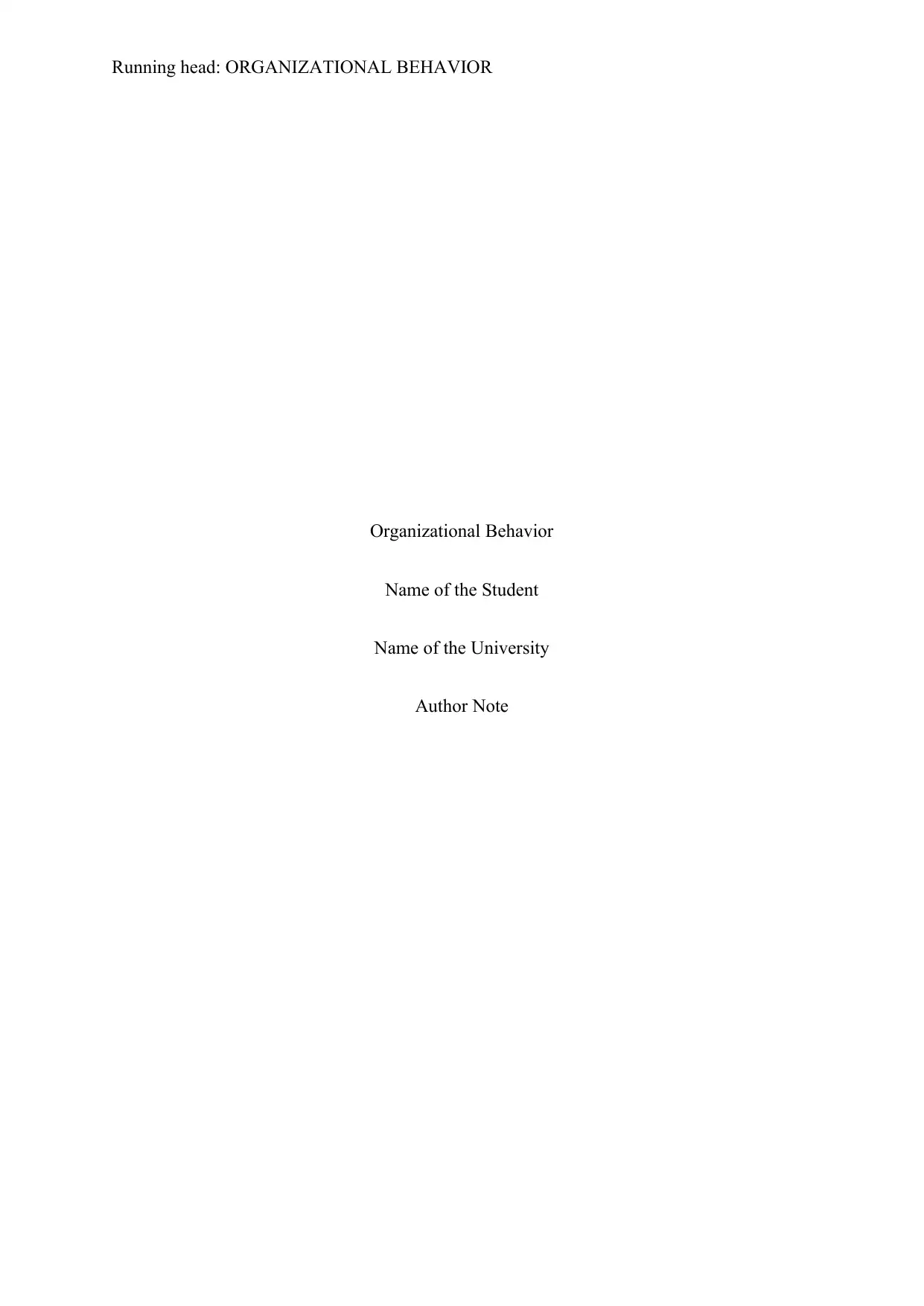
Running head: ORGANIZATIONAL BEHAVIOR
Organizational Behavior
Name of the Student
Name of the University
Author Note
Organizational Behavior
Name of the Student
Name of the University
Author Note
Paraphrase This Document
Need a fresh take? Get an instant paraphrase of this document with our AI Paraphraser
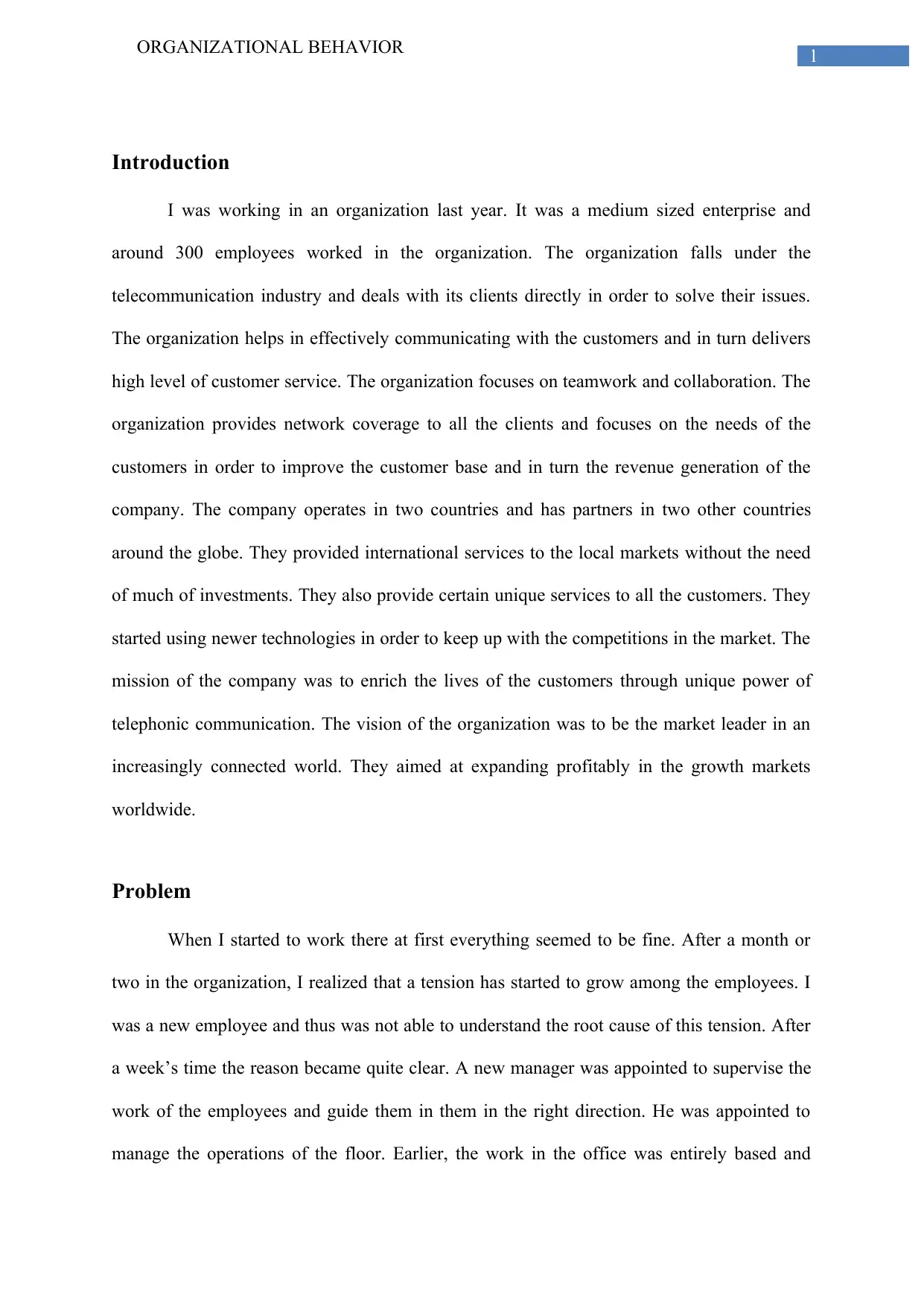
1ORGANIZATIONAL BEHAVIOR
Introduction
I was working in an organization last year. It was a medium sized enterprise and
around 300 employees worked in the organization. The organization falls under the
telecommunication industry and deals with its clients directly in order to solve their issues.
The organization helps in effectively communicating with the customers and in turn delivers
high level of customer service. The organization focuses on teamwork and collaboration. The
organization provides network coverage to all the clients and focuses on the needs of the
customers in order to improve the customer base and in turn the revenue generation of the
company. The company operates in two countries and has partners in two other countries
around the globe. They provided international services to the local markets without the need
of much of investments. They also provide certain unique services to all the customers. They
started using newer technologies in order to keep up with the competitions in the market. The
mission of the company was to enrich the lives of the customers through unique power of
telephonic communication. The vision of the organization was to be the market leader in an
increasingly connected world. They aimed at expanding profitably in the growth markets
worldwide.
Problem
When I started to work there at first everything seemed to be fine. After a month or
two in the organization, I realized that a tension has started to grow among the employees. I
was a new employee and thus was not able to understand the root cause of this tension. After
a week’s time the reason became quite clear. A new manager was appointed to supervise the
work of the employees and guide them in them in the right direction. He was appointed to
manage the operations of the floor. Earlier, the work in the office was entirely based and
Introduction
I was working in an organization last year. It was a medium sized enterprise and
around 300 employees worked in the organization. The organization falls under the
telecommunication industry and deals with its clients directly in order to solve their issues.
The organization helps in effectively communicating with the customers and in turn delivers
high level of customer service. The organization focuses on teamwork and collaboration. The
organization provides network coverage to all the clients and focuses on the needs of the
customers in order to improve the customer base and in turn the revenue generation of the
company. The company operates in two countries and has partners in two other countries
around the globe. They provided international services to the local markets without the need
of much of investments. They also provide certain unique services to all the customers. They
started using newer technologies in order to keep up with the competitions in the market. The
mission of the company was to enrich the lives of the customers through unique power of
telephonic communication. The vision of the organization was to be the market leader in an
increasingly connected world. They aimed at expanding profitably in the growth markets
worldwide.
Problem
When I started to work there at first everything seemed to be fine. After a month or
two in the organization, I realized that a tension has started to grow among the employees. I
was a new employee and thus was not able to understand the root cause of this tension. After
a week’s time the reason became quite clear. A new manager was appointed to supervise the
work of the employees and guide them in them in the right direction. He was appointed to
manage the operations of the floor. Earlier, the work in the office was entirely based and
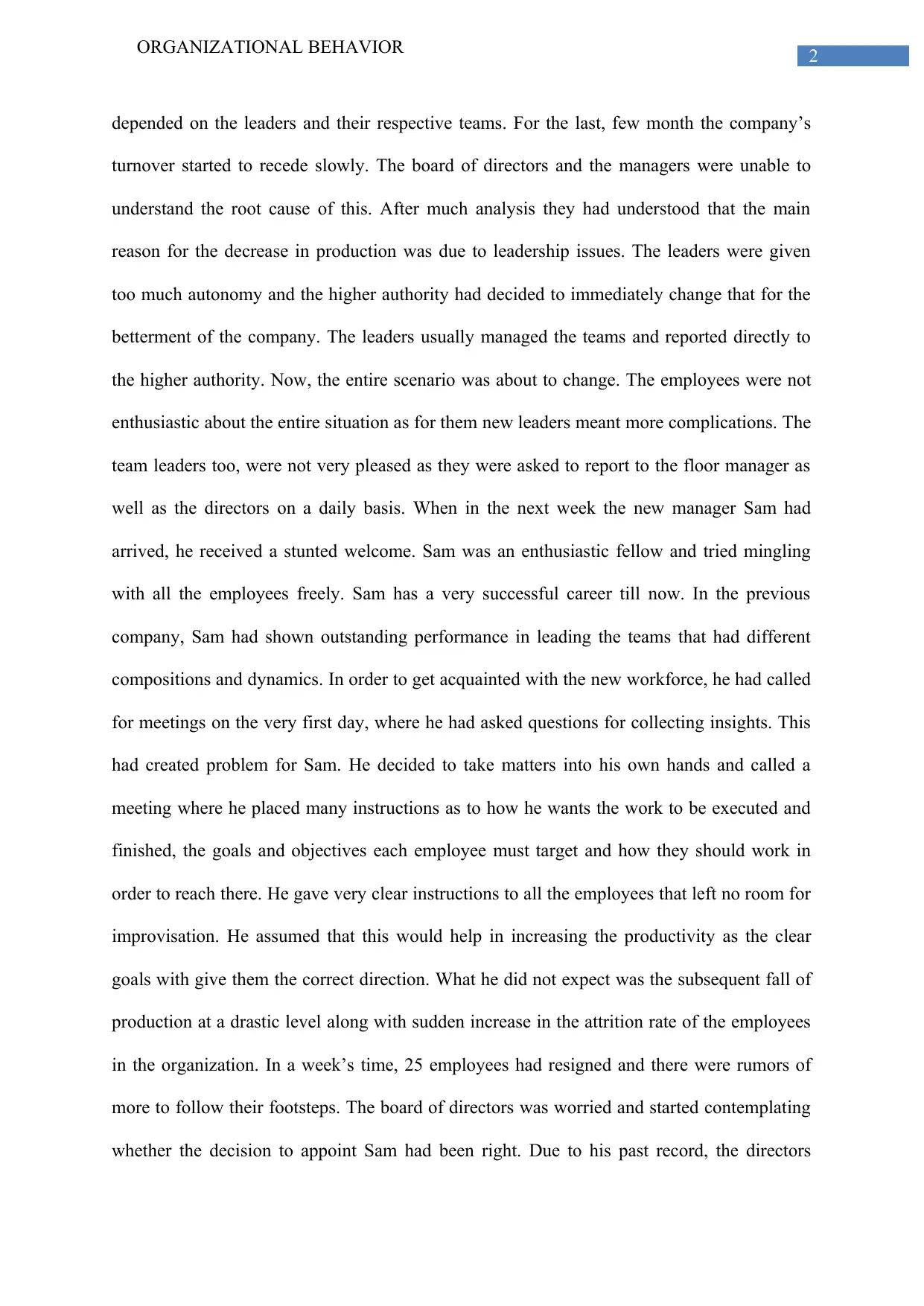
2ORGANIZATIONAL BEHAVIOR
depended on the leaders and their respective teams. For the last, few month the company’s
turnover started to recede slowly. The board of directors and the managers were unable to
understand the root cause of this. After much analysis they had understood that the main
reason for the decrease in production was due to leadership issues. The leaders were given
too much autonomy and the higher authority had decided to immediately change that for the
betterment of the company. The leaders usually managed the teams and reported directly to
the higher authority. Now, the entire scenario was about to change. The employees were not
enthusiastic about the entire situation as for them new leaders meant more complications. The
team leaders too, were not very pleased as they were asked to report to the floor manager as
well as the directors on a daily basis. When in the next week the new manager Sam had
arrived, he received a stunted welcome. Sam was an enthusiastic fellow and tried mingling
with all the employees freely. Sam has a very successful career till now. In the previous
company, Sam had shown outstanding performance in leading the teams that had different
compositions and dynamics. In order to get acquainted with the new workforce, he had called
for meetings on the very first day, where he had asked questions for collecting insights. This
had created problem for Sam. He decided to take matters into his own hands and called a
meeting where he placed many instructions as to how he wants the work to be executed and
finished, the goals and objectives each employee must target and how they should work in
order to reach there. He gave very clear instructions to all the employees that left no room for
improvisation. He assumed that this would help in increasing the productivity as the clear
goals with give them the correct direction. What he did not expect was the subsequent fall of
production at a drastic level along with sudden increase in the attrition rate of the employees
in the organization. In a week’s time, 25 employees had resigned and there were rumors of
more to follow their footsteps. The board of directors was worried and started contemplating
whether the decision to appoint Sam had been right. Due to his past record, the directors
depended on the leaders and their respective teams. For the last, few month the company’s
turnover started to recede slowly. The board of directors and the managers were unable to
understand the root cause of this. After much analysis they had understood that the main
reason for the decrease in production was due to leadership issues. The leaders were given
too much autonomy and the higher authority had decided to immediately change that for the
betterment of the company. The leaders usually managed the teams and reported directly to
the higher authority. Now, the entire scenario was about to change. The employees were not
enthusiastic about the entire situation as for them new leaders meant more complications. The
team leaders too, were not very pleased as they were asked to report to the floor manager as
well as the directors on a daily basis. When in the next week the new manager Sam had
arrived, he received a stunted welcome. Sam was an enthusiastic fellow and tried mingling
with all the employees freely. Sam has a very successful career till now. In the previous
company, Sam had shown outstanding performance in leading the teams that had different
compositions and dynamics. In order to get acquainted with the new workforce, he had called
for meetings on the very first day, where he had asked questions for collecting insights. This
had created problem for Sam. He decided to take matters into his own hands and called a
meeting where he placed many instructions as to how he wants the work to be executed and
finished, the goals and objectives each employee must target and how they should work in
order to reach there. He gave very clear instructions to all the employees that left no room for
improvisation. He assumed that this would help in increasing the productivity as the clear
goals with give them the correct direction. What he did not expect was the subsequent fall of
production at a drastic level along with sudden increase in the attrition rate of the employees
in the organization. In a week’s time, 25 employees had resigned and there were rumors of
more to follow their footsteps. The board of directors was worried and started contemplating
whether the decision to appoint Sam had been right. Due to his past record, the directors
⊘ This is a preview!⊘
Do you want full access?
Subscribe today to unlock all pages.

Trusted by 1+ million students worldwide
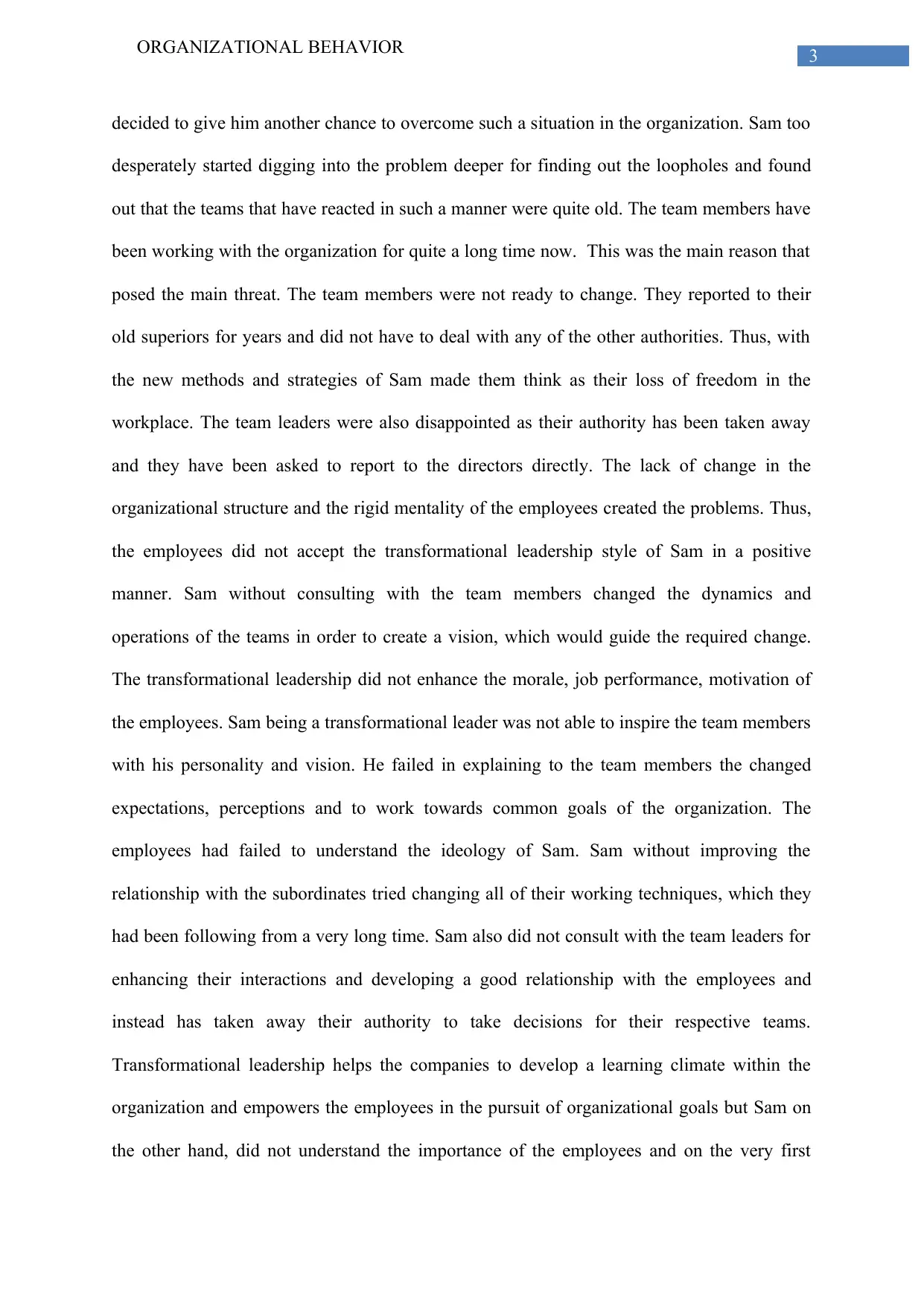
3ORGANIZATIONAL BEHAVIOR
decided to give him another chance to overcome such a situation in the organization. Sam too
desperately started digging into the problem deeper for finding out the loopholes and found
out that the teams that have reacted in such a manner were quite old. The team members have
been working with the organization for quite a long time now. This was the main reason that
posed the main threat. The team members were not ready to change. They reported to their
old superiors for years and did not have to deal with any of the other authorities. Thus, with
the new methods and strategies of Sam made them think as their loss of freedom in the
workplace. The team leaders were also disappointed as their authority has been taken away
and they have been asked to report to the directors directly. The lack of change in the
organizational structure and the rigid mentality of the employees created the problems. Thus,
the employees did not accept the transformational leadership style of Sam in a positive
manner. Sam without consulting with the team members changed the dynamics and
operations of the teams in order to create a vision, which would guide the required change.
The transformational leadership did not enhance the morale, job performance, motivation of
the employees. Sam being a transformational leader was not able to inspire the team members
with his personality and vision. He failed in explaining to the team members the changed
expectations, perceptions and to work towards common goals of the organization. The
employees had failed to understand the ideology of Sam. Sam without improving the
relationship with the subordinates tried changing all of their working techniques, which they
had been following from a very long time. Sam also did not consult with the team leaders for
enhancing their interactions and developing a good relationship with the employees and
instead has taken away their authority to take decisions for their respective teams.
Transformational leadership helps the companies to develop a learning climate within the
organization and empowers the employees in the pursuit of organizational goals but Sam on
the other hand, did not understand the importance of the employees and on the very first
decided to give him another chance to overcome such a situation in the organization. Sam too
desperately started digging into the problem deeper for finding out the loopholes and found
out that the teams that have reacted in such a manner were quite old. The team members have
been working with the organization for quite a long time now. This was the main reason that
posed the main threat. The team members were not ready to change. They reported to their
old superiors for years and did not have to deal with any of the other authorities. Thus, with
the new methods and strategies of Sam made them think as their loss of freedom in the
workplace. The team leaders were also disappointed as their authority has been taken away
and they have been asked to report to the directors directly. The lack of change in the
organizational structure and the rigid mentality of the employees created the problems. Thus,
the employees did not accept the transformational leadership style of Sam in a positive
manner. Sam without consulting with the team members changed the dynamics and
operations of the teams in order to create a vision, which would guide the required change.
The transformational leadership did not enhance the morale, job performance, motivation of
the employees. Sam being a transformational leader was not able to inspire the team members
with his personality and vision. He failed in explaining to the team members the changed
expectations, perceptions and to work towards common goals of the organization. The
employees had failed to understand the ideology of Sam. Sam without improving the
relationship with the subordinates tried changing all of their working techniques, which they
had been following from a very long time. Sam also did not consult with the team leaders for
enhancing their interactions and developing a good relationship with the employees and
instead has taken away their authority to take decisions for their respective teams.
Transformational leadership helps the companies to develop a learning climate within the
organization and empowers the employees in the pursuit of organizational goals but Sam on
the other hand, did not understand the importance of the employees and on the very first
Paraphrase This Document
Need a fresh take? Get an instant paraphrase of this document with our AI Paraphraser
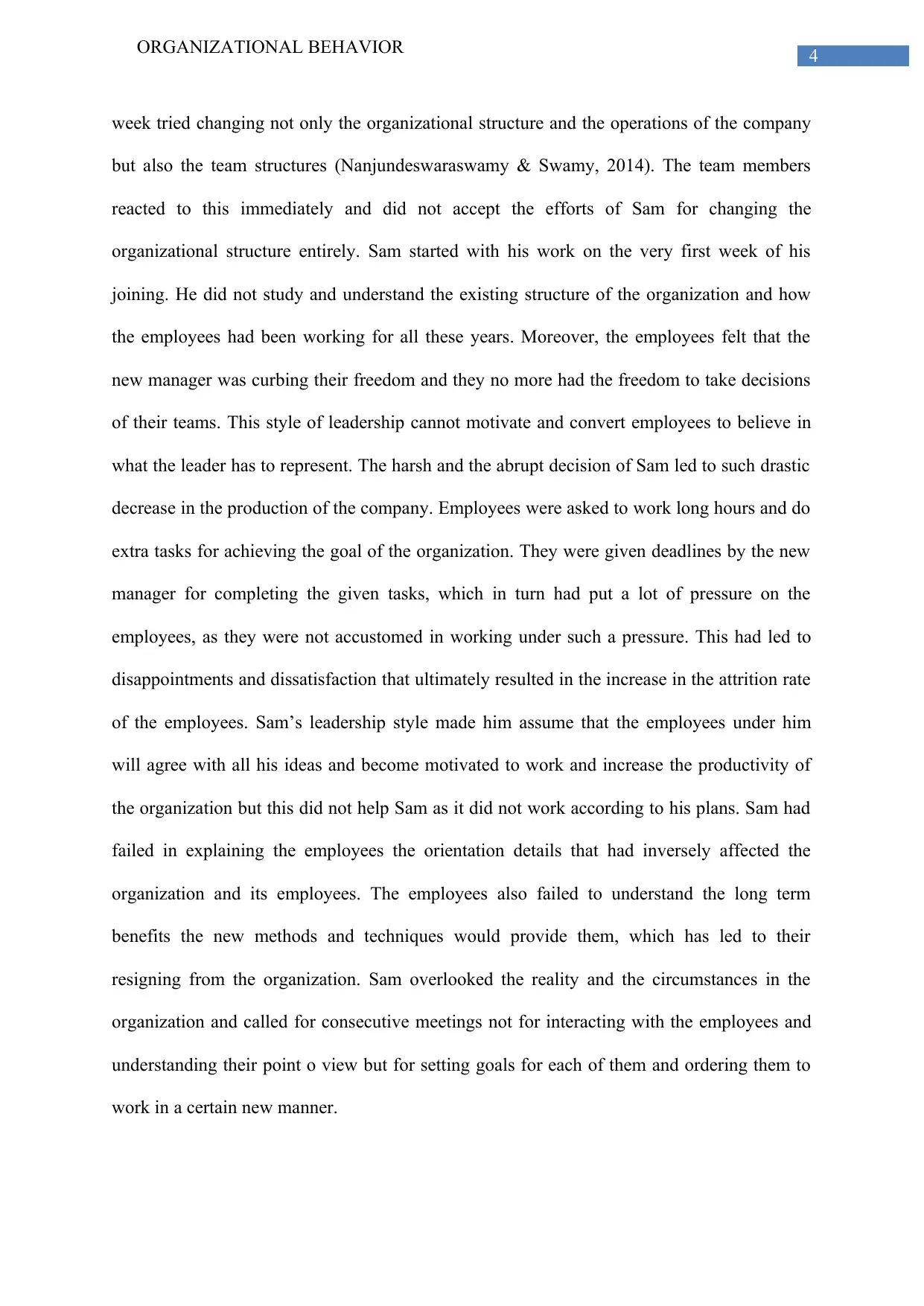
4ORGANIZATIONAL BEHAVIOR
week tried changing not only the organizational structure and the operations of the company
but also the team structures (Nanjundeswaraswamy & Swamy, 2014). The team members
reacted to this immediately and did not accept the efforts of Sam for changing the
organizational structure entirely. Sam started with his work on the very first week of his
joining. He did not study and understand the existing structure of the organization and how
the employees had been working for all these years. Moreover, the employees felt that the
new manager was curbing their freedom and they no more had the freedom to take decisions
of their teams. This style of leadership cannot motivate and convert employees to believe in
what the leader has to represent. The harsh and the abrupt decision of Sam led to such drastic
decrease in the production of the company. Employees were asked to work long hours and do
extra tasks for achieving the goal of the organization. They were given deadlines by the new
manager for completing the given tasks, which in turn had put a lot of pressure on the
employees, as they were not accustomed in working under such a pressure. This had led to
disappointments and dissatisfaction that ultimately resulted in the increase in the attrition rate
of the employees. Sam’s leadership style made him assume that the employees under him
will agree with all his ideas and become motivated to work and increase the productivity of
the organization but this did not help Sam as it did not work according to his plans. Sam had
failed in explaining the employees the orientation details that had inversely affected the
organization and its employees. The employees also failed to understand the long term
benefits the new methods and techniques would provide them, which has led to their
resigning from the organization. Sam overlooked the reality and the circumstances in the
organization and called for consecutive meetings not for interacting with the employees and
understanding their point o view but for setting goals for each of them and ordering them to
work in a certain new manner.
week tried changing not only the organizational structure and the operations of the company
but also the team structures (Nanjundeswaraswamy & Swamy, 2014). The team members
reacted to this immediately and did not accept the efforts of Sam for changing the
organizational structure entirely. Sam started with his work on the very first week of his
joining. He did not study and understand the existing structure of the organization and how
the employees had been working for all these years. Moreover, the employees felt that the
new manager was curbing their freedom and they no more had the freedom to take decisions
of their teams. This style of leadership cannot motivate and convert employees to believe in
what the leader has to represent. The harsh and the abrupt decision of Sam led to such drastic
decrease in the production of the company. Employees were asked to work long hours and do
extra tasks for achieving the goal of the organization. They were given deadlines by the new
manager for completing the given tasks, which in turn had put a lot of pressure on the
employees, as they were not accustomed in working under such a pressure. This had led to
disappointments and dissatisfaction that ultimately resulted in the increase in the attrition rate
of the employees. Sam’s leadership style made him assume that the employees under him
will agree with all his ideas and become motivated to work and increase the productivity of
the organization but this did not help Sam as it did not work according to his plans. Sam had
failed in explaining the employees the orientation details that had inversely affected the
organization and its employees. The employees also failed to understand the long term
benefits the new methods and techniques would provide them, which has led to their
resigning from the organization. Sam overlooked the reality and the circumstances in the
organization and called for consecutive meetings not for interacting with the employees and
understanding their point o view but for setting goals for each of them and ordering them to
work in a certain new manner.
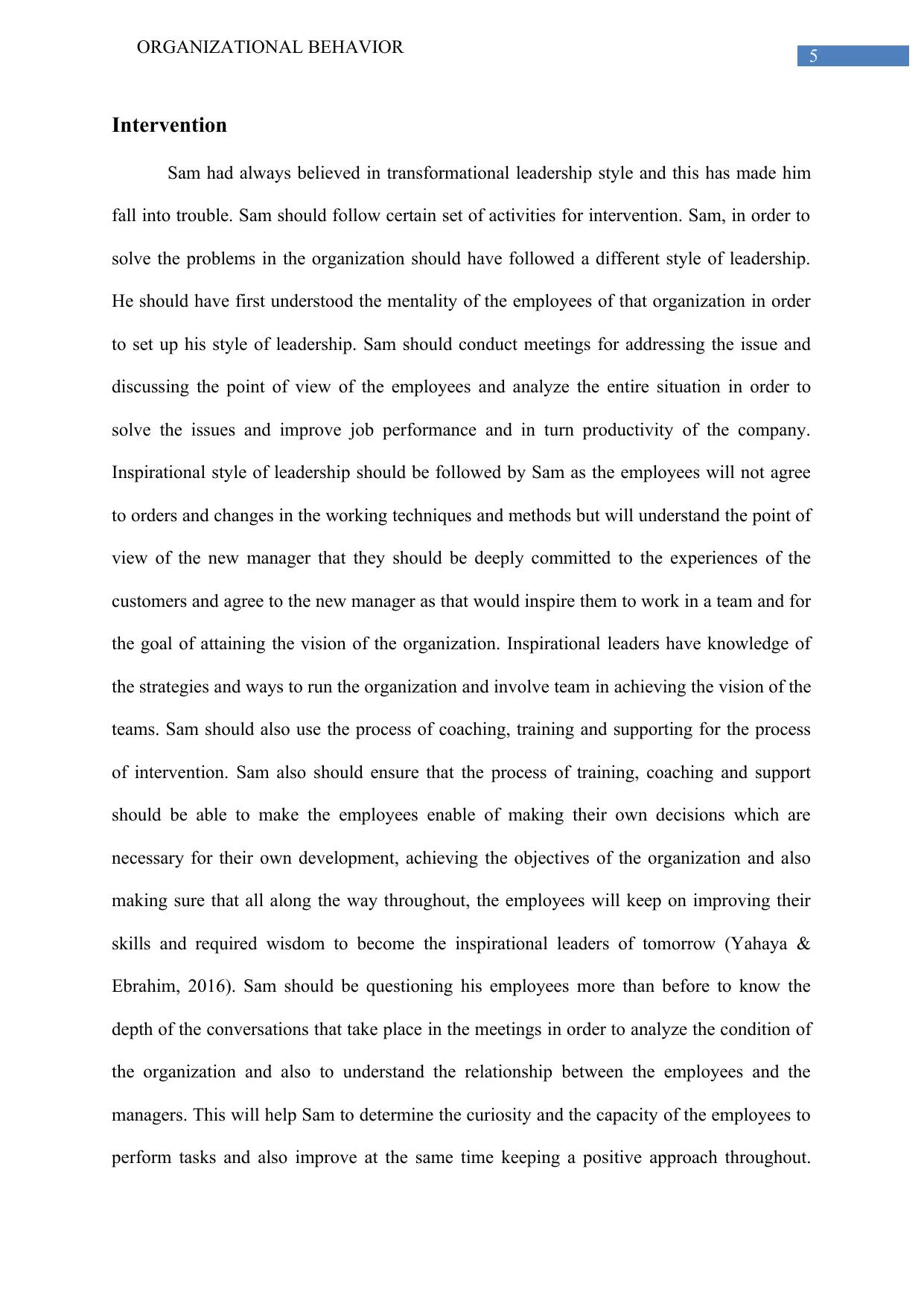
5ORGANIZATIONAL BEHAVIOR
Intervention
Sam had always believed in transformational leadership style and this has made him
fall into trouble. Sam should follow certain set of activities for intervention. Sam, in order to
solve the problems in the organization should have followed a different style of leadership.
He should have first understood the mentality of the employees of that organization in order
to set up his style of leadership. Sam should conduct meetings for addressing the issue and
discussing the point of view of the employees and analyze the entire situation in order to
solve the issues and improve job performance and in turn productivity of the company.
Inspirational style of leadership should be followed by Sam as the employees will not agree
to orders and changes in the working techniques and methods but will understand the point of
view of the new manager that they should be deeply committed to the experiences of the
customers and agree to the new manager as that would inspire them to work in a team and for
the goal of attaining the vision of the organization. Inspirational leaders have knowledge of
the strategies and ways to run the organization and involve team in achieving the vision of the
teams. Sam should also use the process of coaching, training and supporting for the process
of intervention. Sam also should ensure that the process of training, coaching and support
should be able to make the employees enable of making their own decisions which are
necessary for their own development, achieving the objectives of the organization and also
making sure that all along the way throughout, the employees will keep on improving their
skills and required wisdom to become the inspirational leaders of tomorrow (Yahaya &
Ebrahim, 2016). Sam should be questioning his employees more than before to know the
depth of the conversations that take place in the meetings in order to analyze the condition of
the organization and also to understand the relationship between the employees and the
managers. This will help Sam to determine the curiosity and the capacity of the employees to
perform tasks and also improve at the same time keeping a positive approach throughout.
Intervention
Sam had always believed in transformational leadership style and this has made him
fall into trouble. Sam should follow certain set of activities for intervention. Sam, in order to
solve the problems in the organization should have followed a different style of leadership.
He should have first understood the mentality of the employees of that organization in order
to set up his style of leadership. Sam should conduct meetings for addressing the issue and
discussing the point of view of the employees and analyze the entire situation in order to
solve the issues and improve job performance and in turn productivity of the company.
Inspirational style of leadership should be followed by Sam as the employees will not agree
to orders and changes in the working techniques and methods but will understand the point of
view of the new manager that they should be deeply committed to the experiences of the
customers and agree to the new manager as that would inspire them to work in a team and for
the goal of attaining the vision of the organization. Inspirational leaders have knowledge of
the strategies and ways to run the organization and involve team in achieving the vision of the
teams. Sam should also use the process of coaching, training and supporting for the process
of intervention. Sam also should ensure that the process of training, coaching and support
should be able to make the employees enable of making their own decisions which are
necessary for their own development, achieving the objectives of the organization and also
making sure that all along the way throughout, the employees will keep on improving their
skills and required wisdom to become the inspirational leaders of tomorrow (Yahaya &
Ebrahim, 2016). Sam should be questioning his employees more than before to know the
depth of the conversations that take place in the meetings in order to analyze the condition of
the organization and also to understand the relationship between the employees and the
managers. This will help Sam to determine the curiosity and the capacity of the employees to
perform tasks and also improve at the same time keeping a positive approach throughout.
⊘ This is a preview!⊘
Do you want full access?
Subscribe today to unlock all pages.

Trusted by 1+ million students worldwide
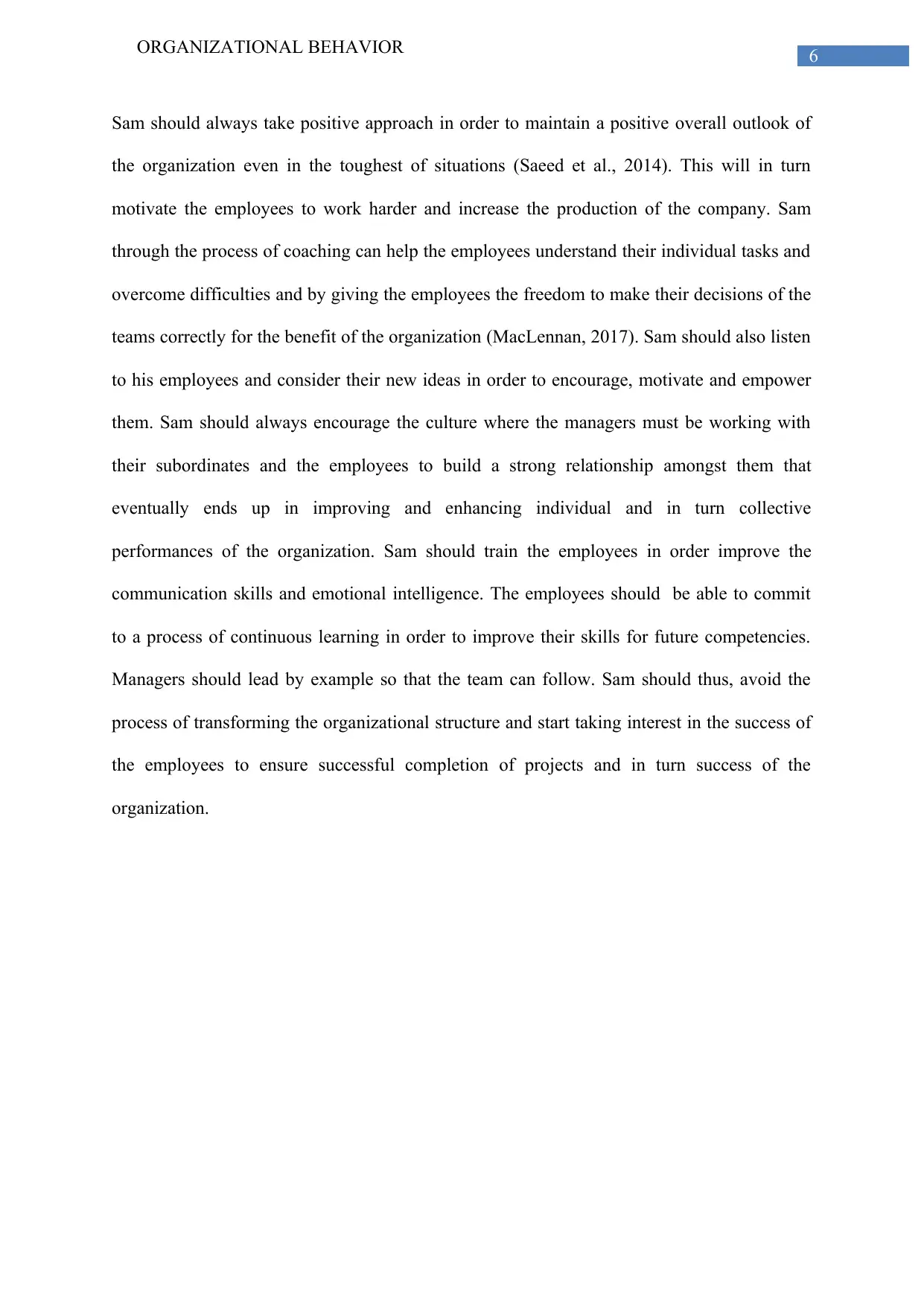
6ORGANIZATIONAL BEHAVIOR
Sam should always take positive approach in order to maintain a positive overall outlook of
the organization even in the toughest of situations (Saeed et al., 2014). This will in turn
motivate the employees to work harder and increase the production of the company. Sam
through the process of coaching can help the employees understand their individual tasks and
overcome difficulties and by giving the employees the freedom to make their decisions of the
teams correctly for the benefit of the organization (MacLennan, 2017). Sam should also listen
to his employees and consider their new ideas in order to encourage, motivate and empower
them. Sam should always encourage the culture where the managers must be working with
their subordinates and the employees to build a strong relationship amongst them that
eventually ends up in improving and enhancing individual and in turn collective
performances of the organization. Sam should train the employees in order improve the
communication skills and emotional intelligence. The employees should be able to commit
to a process of continuous learning in order to improve their skills for future competencies.
Managers should lead by example so that the team can follow. Sam should thus, avoid the
process of transforming the organizational structure and start taking interest in the success of
the employees to ensure successful completion of projects and in turn success of the
organization.
Sam should always take positive approach in order to maintain a positive overall outlook of
the organization even in the toughest of situations (Saeed et al., 2014). This will in turn
motivate the employees to work harder and increase the production of the company. Sam
through the process of coaching can help the employees understand their individual tasks and
overcome difficulties and by giving the employees the freedom to make their decisions of the
teams correctly for the benefit of the organization (MacLennan, 2017). Sam should also listen
to his employees and consider their new ideas in order to encourage, motivate and empower
them. Sam should always encourage the culture where the managers must be working with
their subordinates and the employees to build a strong relationship amongst them that
eventually ends up in improving and enhancing individual and in turn collective
performances of the organization. Sam should train the employees in order improve the
communication skills and emotional intelligence. The employees should be able to commit
to a process of continuous learning in order to improve their skills for future competencies.
Managers should lead by example so that the team can follow. Sam should thus, avoid the
process of transforming the organizational structure and start taking interest in the success of
the employees to ensure successful completion of projects and in turn success of the
organization.
Paraphrase This Document
Need a fresh take? Get an instant paraphrase of this document with our AI Paraphraser
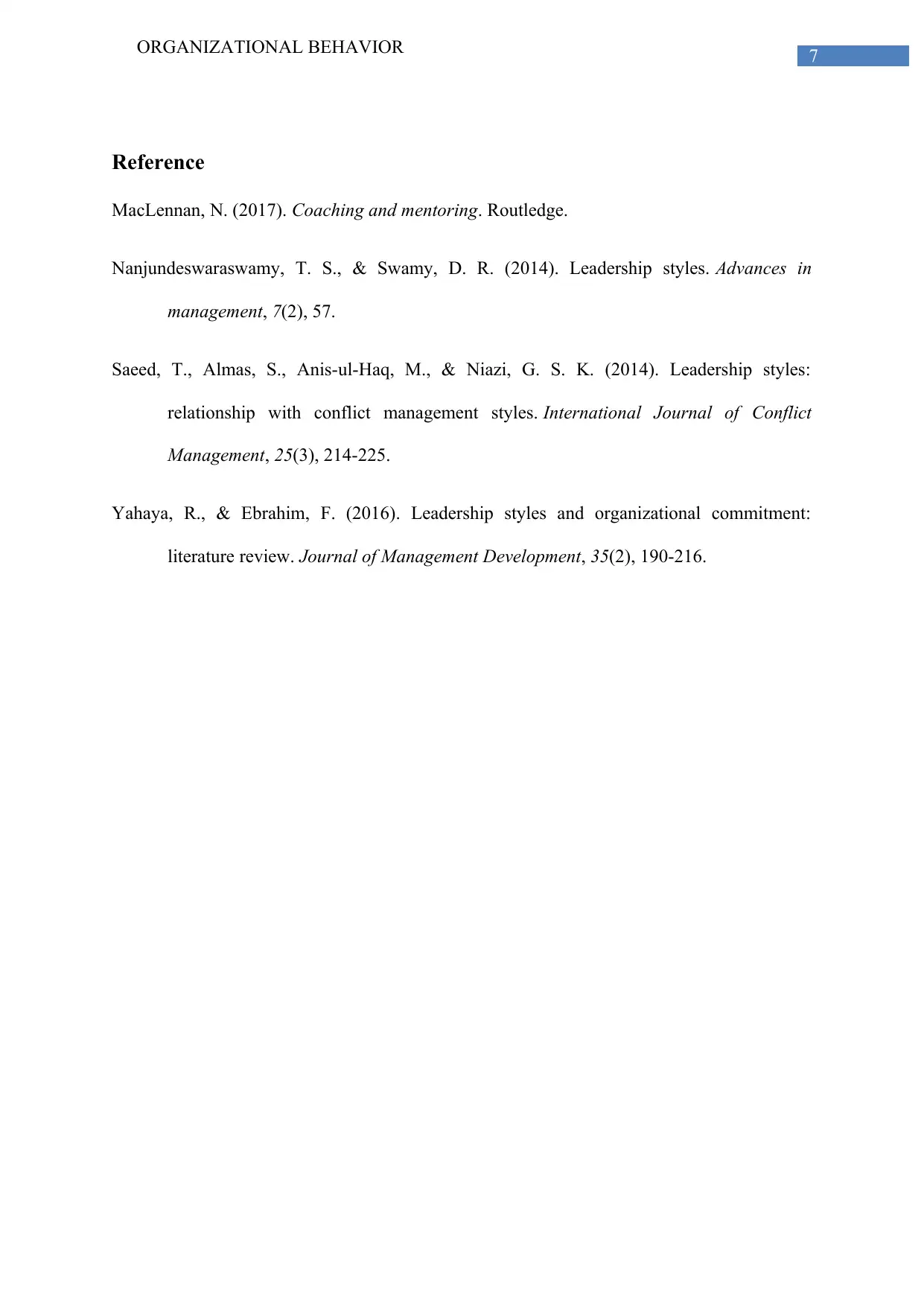
7ORGANIZATIONAL BEHAVIOR
Reference
MacLennan, N. (2017). Coaching and mentoring. Routledge.
Nanjundeswaraswamy, T. S., & Swamy, D. R. (2014). Leadership styles. Advances in
management, 7(2), 57.
Saeed, T., Almas, S., Anis-ul-Haq, M., & Niazi, G. S. K. (2014). Leadership styles:
relationship with conflict management styles. International Journal of Conflict
Management, 25(3), 214-225.
Yahaya, R., & Ebrahim, F. (2016). Leadership styles and organizational commitment:
literature review. Journal of Management Development, 35(2), 190-216.
Reference
MacLennan, N. (2017). Coaching and mentoring. Routledge.
Nanjundeswaraswamy, T. S., & Swamy, D. R. (2014). Leadership styles. Advances in
management, 7(2), 57.
Saeed, T., Almas, S., Anis-ul-Haq, M., & Niazi, G. S. K. (2014). Leadership styles:
relationship with conflict management styles. International Journal of Conflict
Management, 25(3), 214-225.
Yahaya, R., & Ebrahim, F. (2016). Leadership styles and organizational commitment:
literature review. Journal of Management Development, 35(2), 190-216.
1 out of 8
Related Documents
Your All-in-One AI-Powered Toolkit for Academic Success.
+13062052269
info@desklib.com
Available 24*7 on WhatsApp / Email
![[object Object]](/_next/static/media/star-bottom.7253800d.svg)
Unlock your academic potential
Copyright © 2020–2025 A2Z Services. All Rights Reserved. Developed and managed by ZUCOL.





